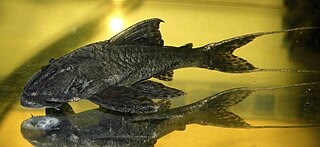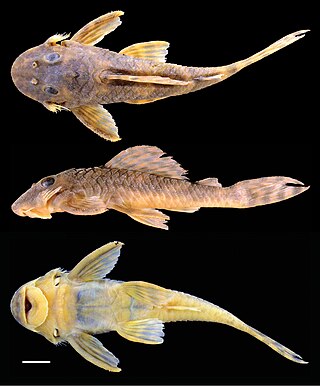
Baryancistrus is a genus of freshwater Loricariid catfish. They inhabit flowing sections of rivers, especially clearwater, in the basins of the Amazon and Orinoco in Brazil and Venezuela. The largest species reach up to 34 cm (13 in) in total length.

Peckoltia is a genus of small South American armored suckermouth catfishes. Many of these fish are popular aquarium fish.

Hemiancistrus is a genus of suckermouth armored catfishes. These species are native to South America. The taxonomy of this genus is complex and unclear, and major work has to be done. Many of these fish are popular aquarium fish.
Peckoltia relictum is a species of armored catfish where it is found in the upper Marañon River in northern Peru.

Peckoltia sabaji is a species of catfish in the family Loricariidae. It is native to South America, where it occurs in the basins of the Rupununi, the Essequibo River, and the Takutu River in Guyana, as well as the basins of the Casiquiare canal, the Rio Negro, the Cinaruco River, and the Orinoco in Venezuela. It is usually found among boulders in medium to large rivers. The species reaches 19.8 cm SL and is of disputed classification.

Peckoltia vittata is a species of catfish belonging to the subfamily Hypostominae of the family Loricariidae.

Peckoltia pankimpuju is a species of armored catfish from the family Loricariidae, native to the Marañón River in the upper Amazon basin of Peru. It is commonly called the coal pleco, Peruvian lyre-tail, and L350 under the L-number code. It reaches up to about 40 cm (16 in) in length.
Hemiancistrus guahiborum is a species of catfish in the family Loricariidae. It is native to South America, where it occurs in the Orinoco drainage in Venezuela. The species reaches at least 12.55 cm SL and was described in 2005 by David C. Werneke and Jonathan W. Armbruster of Auburn University, Nathan K. Lujan of the American Museum of Natural History, and Donald C. Taphorn of the Royal Ontario Museum on the basis of its distinctive coloration and morphology. It appears in the aquarium trade, where it is usually known either as the orange-seam pleco or by its L-number, which is L-106.
Peckoltia cavatica is a species of catfish in the family Loricariidae. It is native to South America, where it occurs in the Rupununi basin in Guyana. It is found in areas with large amounts of lateritic rock, and it is usually seen in holes and caves within the rock, which are also where it is thought to breed. P. cavatica's preference for such environments was notable enough to the authors of its 2005 description, Jonathan W. Armbruster and David C. Werneke, that the specific epithet bestowed upon it means "living in caves" in Latin. The species reaches 7.2 cm SL.

Peckoltia ephippiata is a species of catfish in the family Loricariidae. It is a freshwater fish native to South America, where it is known from the Leitão River, which is part of the Madeira River drainage in the state of Rôndonia in Brazil. The species reaches 10.2 cm SL.

Peckoltia lujani is a species of catfish in the family Loricariidae. It is native to South America, where it occurs in the Orinoco and Meta River basins in Venezuela and Colombia. The species reaches 7.5 cm SL.

Peckoltia wernekei is a species of catfish in the family Loricariidae. It is native to South America, where it occurs in the Ventuari River, which is a tributary of the Orinoco in the state of Amazonas in Venezuela. The species reaches at least 10.46 cm SL.
'Pseudancistrus' megacephalus is a species of catfish in the family Loricariidae. It is of uncertain and disputed classification.
Hypostomus salgadae is a disputed species of catfish in the family Loricariidae that may be synonymous with the species Hypostomus carvalhoi. It is native to South America, where it occurs in the Jaguaribe River basin in Brazil. FishBase reports the maximum length of the species as 2 cm in standard length, but it is likely that the species can exceed this size. It is believed to be a facultative or obligate air-breather.
Hypostomus aspidolepis is a species of catfish in the family Loricariidae that is of disputed taxonomic identity. It is a freshwater fish native to Central America, where it occurs in the Gatún River basin in the Caribbean coastal drainage of Panama. The species reaches 40 cm in standard length and is believed to be a facultative air-breather. Although originally described as a member of Chaetostomus by Albert Günther in 1867, it has subsequently been classified within Hypostomus, the now-invalid genus Plecostomus, and Hemiancistrus. A 2015 review conducted by Jonathan W. Armbruster, David C. Werneke, and Milton Tan recognized the species within Hypostomus, although sources such as FishBase, WoRMS and ITIS still consider it a member of Hemiancistrus.
Hypostomus maracaiboensis is a species of catfish in the family Loricariidae. It is native to South America, where it occurs in the Lake Maracaibo basin in Venezuela. The species feeds on algae and detritus, reaches 28.5 cm in total length, and is believed to be a facultative air-breather. The species was originally described by Leonard Peter Schultz in 1944 as a member of Hemiancistrus, and some sources continue to refer to it as such. In 2015, a taxonomic review conducted by Jonathan W. Armbruster, David C. Werneke, and Milton Tan reclassified it and recognized it as a member of Hypostomus.
Ancistomus micrommatos is a species of catfish in the family Loricariidae. It is a freshwater fish native to South America, where it is known only from the Tocantins River basin in Brazil. The species reaches 11.9 cm in standard length. Although originally described as a species of Hemiancistrus in 2003, a 2015 review conducted by Jonathan W. Armbruster, David C. Werneke, and Milton Tan listed the species as valid within Ancistomus. The same review also reported that no characteristics were found to separate A. micrommatos from its congeners A. spilomma and A. spinosissimus, indicating that the three may actually all be the same species.
Ancistomus spilomma is a species of catfish in the family Loricariidae. It is native to South America, where it is known only from the Tocantins River basin in Brazil. The species reaches 14.2 cm in standard length. Although originally described as a species of Hemiancistrus in 2003, a 2015 review conducted by Jonathan W. Armbruster, David C. Werneke, and Milton Tan listed the species as valid within Ancistomus. The same review also reported that no characteristics were found to separate A. spilomma from its congeners A. micrommatos and A. spinosissimus, indicating that the three may actually all be the same species.
Ancistomus spinosissimus is a species of catfish in the family Loricariidae. It is a freshwater fish native to South America, where it is known only from the upper and middle Tocantins River basin in Brazil. The species reaches 12.7 cm in standard length. Although originally described as a species of Hemiancistrus in 2003, a 2015 review conducted by Jonathan W. Armbruster, David C. Werneke, and Milton Tan listed the species as valid within Ancistomus. The same review also reported that no characteristics were found to separate A. spinosissimus from its congeners A. micrommatos and A. spilomma, indicating that the three may actually all be the same species.
Ancistomus snethlageae is a species of catfish in the family Loricariidae. It is native to South America, where it occurs in the Tapajós basin in Brazil. The species reaches 22 cm in total length. Although originally described as a species of Ancistrus in 1911 by Franz Steindachner and subsequently reclassified in the genera Hemiancistrus, Lasiancistrus, and Peckoltia, a 2015 review conducted by Jonathan W. Armbruster, David C. Werneke, and Milton Tan listed the species as valid within Ancistomus.








